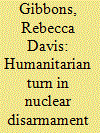| Srl | Item |
| 1 |
ID:
165274


|
|
|
| 2 |
ID:
185994


|
|
|
|
|
| Summary/Abstract |
The regime built around the 1970 Treaty on the Non-Proliferation of Nuclear Weapons (NPT) has helped curtail the spread of nuclear arms for fifty years. In hindsight, it is remarkable only nine states possess the world’s most powerful weapon. The NPT achieved much success during Cold War bipolarity and U.S. unipolarity in its aftermath. But today, China’s rise and Russia’s resurgence have ushered in a new era of emerging multipolarity. Can the treaty withstand the potential challenges of this dynamic environment? There is a real risk that multipolarity may shake the scaffolding of the nonproliferation regime, presenting a significant test to the NPT’s durability. This article identifies four essential elements of the nonproliferation regime: widespread membership, adaptability, enforcement, and fairness. History suggests bipolarity and unipolarity in the international system largely sustained and promoted these NPT features. When international regimes lack such elements, it sharply curtails their long-term efficacy.
|
|
|
|
|
|
|
|
|
|
|
|
|
|
|
|
| 3 |
ID:
166070


|
|
|
|
|
| Summary/Abstract |
Foreign policy pundits have bemoaned the unraveling of the post-World War II international order in recent years, describing threats to the multilateralism and liberalism enshrined in postwar institutions. An often overlooked component of that structure is the global nuclear order, which, like other parts of the postwar system, was created for magnanimous and selfish aims: reducing the dangers of nuclear weapons for all and serving the interests of the world’s most powerful states.
|
|
|
|
|
|
|
|
|
|
|
|
|
|
|
|
| 4 |
ID:
160980


|
|
|
|
|
| Summary/Abstract |
On July 7, 2017, at the UN General Assembly, 122 states voted to adopt the Treaty on the Prohibition of Nuclear Weapons. This was the culmination of the work of a global network of states and grassroots activists that emphasized the devastating humanitarian consequences of nuclear-weapons use in order to delegitimize their possession. Advocates of the ban treaty are frustrated with the slow pace of nuclear disarmament through traditional channels. This article traces the history of the ban movement from 2005 to the present. It concludes by highlighting six factors that led to the successful adoption of the treaty: a small group of committed diplomats; an influx of new coalition members; the contribution of civil society; the reframing of the narrative surrounding nuclear weapons; the pursuit of a simple ban treaty; and the context provided by the Barack Obama administration.
|
|
|
|
|
|
|
|
|
|
|
|
|
|
|
|